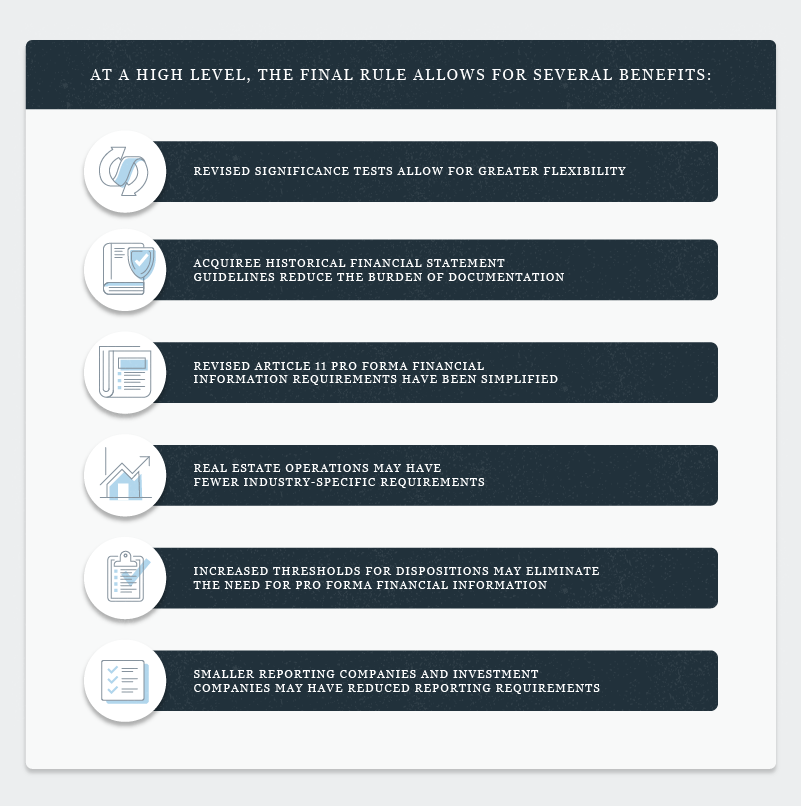
On May 20, 2020, the Securities and Exchange Commission (SEC) issued a final rule that amends the financial reporting requirements for acquisitions and dispositions of businesses, including the related pro forma reporting requirements. The amendments are largely intended to simplify and streamline the historical financial statement requirements of acquired businesses pursuant to Regulation S-X Rule 3-05 and Rule 3-14 and registrants’ pro forma financial information required by Article 11.
In a May 21, 2020, press release, the SEC indicated that certain parts of Regulation S-X have not been comprehensively updated since their adoption dates more than 30 years ago. Recent amendments are “designed to enhance the quality of information that investors receive while eliminating unnecessary costs and burdens, [and] will benefit investors, registrants and the market,” according to Chairman Jay Clayton.
The final rule, which applies to existing registrants and companies conducting an initial public offering (IPO), will be effective January 1, 2021, but entities can early adopt to take advantage of its benefits.
At a high level, the final rule allows for several benefits:

Revised significance tests allow for greater flexibility
Registrants still need to consider three significance tests (i.e., (1) income / revenue, (2) investment and (3) asset) and use the highest of three tests to determine acquiree financial statement requirements. The asset test is not impacted by the final rule. The amendments:
- Update the legacy income test with a two-pronged approach that allows a registrant to use the lower of (1) a revenue test or (2) an income test as the significance level.
- Change the investment test to use a registrant’s aggregate worldwide market value of common equity, as opposed to a registrant’s total assets. If a registrant is a debt-only filer, then it will continue to use its total assets to calculate significance.
- Permit the use of pro forma information to compute significance in certain circumstances.
Acquiree historical financial statement guidelines reduce the burden of documentation
As a result of the final rule, registrants will have less burden to provide acquiree financial statements and/or provide financial statements to a lesser extent. The amendments:
- Reduce the maximum number of audited fiscal years to be presented from three to two, when significance for any of the three tests exceeds 50%.
- Change the interim financial statement presentation to eliminate the comparative prior interim period when only one year of audited financial statements is required (i.e., when significance for any of the three tests exceeds 20%, but not 40%).
- Eliminate the burden of providing acquiree financial statements for a “mathematical majority” of aggregated individually insignificant acquisitions. However, if aggregate significance exceeds 50%, then Article 11 pro forma financial information is required for all individually insignificant businesses acquired since the beginning of the fiscal year, even if separate audited financial statements are not required by Rule 3-05.
- For IPOs, eliminate the need for financial statements when the acquired entity is included in the registrant’s audited results for (1) 9 months, when significance for any of the three tests exceeds 20%, but not 40% or (2) a complete fiscal year, when significance for any of the three tests exceed 40%.
- Allow registrants to use abbreviated financial statements for carve out entities, in lieu of full general-purpose financial statements, without seeking concurrence from the SEC staff, when certain conditions are met.
- Allow acquiree financial statements to be prepared in accordance with IFRS-IASB without reconciliation to U.S. GAAP if the acquired business would qualify to use IFRS-IASB if it were a registrant (i.e., a Foreign Private Issuer).
Revised article 11 pro forma financial information requirements have been simplified
The final rule also simplifies the preparation and presentation requirements for pro forma information. Key amendments include, but are not limited to, the following:
Replace the previous three pro forma adjustment criteria (i.e., (1) directly attributable to the transaction, (2) factually supportable and, (3) with respect to the pro forma income statement, expected to have a continuing impact) with two new categories of adjustments.
- Transaction Accounting Adjustments – Will separately present the accounting adjustments pursuant to U.S. GAAP (or IFRS, as applicable) for the acquisition or disposition, such as purchase accounting and related financing transactions required to consummate the deal (e.g., issuance of common equity and/or stock to consummate the deal).
- Autonomous Entity Adjustments – When an acquisition or disposition was previously part of another entity (e.g., a carve-out or a spin-off), separate adjustments, such as incremental expenses or other changes, will be included to present the acquisition or disposition to illustrate as if it always had been a stand-alone entity. Autonomous entity adjustments are only required when the acquiree or disposal was part of another entity. Therefore, in many cases, these adjustments may not be required in the pro forma financial information.
Permit a registrant to include optional management’s adjustments to illustrate synergies (or dis-synergies) due to the transaction, such as the anticipated impacts of closing facilities, discontinuing product lines, terminating employees, executing new agreements or modifying existing agreements. Registrants should keep in mind that these management “adjustments” are not adjustments that will be reflected on the face of the pro forma financial statements. Instead, when adjustments do not qualify as transaction accounting or autonomous entity adjustments, registrants may include additional disclosures in the footnotes to the pro forma financial information.
Management adjustments may be presented when certain criteria are met.
- There is a reasonable basis for each adjustment.
- The effects are only included for the pro forma periods presented.
- Reductions of expenses may not exceed that which was historically incurred.
- All adjustments that are, in the opinion of management, necessary for a fair presentation of the pro forma financial information are presented. A statement to that effect must be disclosed. When synergies are presented, dis-synergies must also be presented.
Furthermore, certain disclosure criteria must be met when presenting management’s adjustments in the footnotes to the pro forma financial statements, including:
- Adjustments must be presented in the form of reconciliations of pro forma net income and pro forma earnings (loss) per share to such amounts after giving effect to management’s adjustments.
- Disclosure must include discussion of the basis of each of management’s adjustments to provide transparency into its nature, how it was derived and any material limitations. Discussion must also include an expected timeframe as to when expected synergies (or dis-synergies) will be achieved.
- Adjustments must reflect the most current assumptions available as of the effective date of a registration statement or filing date. This could result in changes to previously issued pro forma financial information when it is provided in later filings.
Real estate operations may have fewer industry-specific requirements
Certain registrants that have real estate operations were previously required to comply with the acquisition and disposition rules pursuant to Rule 3-14. The final rule will substantially align the requirements of Rule 3-14 with Rule 3-05, thus eliminating many industry-specific considerations in the application of the significance tests and financial statement requirements. However, certain industry-specific financial statement disclosures will still be retained.
Increased thresholds for dispositions may eliminate the need for pro forma financial information
The final rule raises the significance thresholds for dispositions from 10% to 20% to align with the acquisition significance levels. Rule 3-05 financial statements are not required for dispositions. However, within 4 business days of a disposition, a registrant will need to file a Current Report on Form 8-K that includes pro forma financial information if any of the significance tests exceed 20%.
Smaller reporting companies and investment companies may have reduced reporting requirements
In addition, the final rule includes amendments to certain reporting requirements for Smaller Reporting Companies (SRCs) that file according to Article 8 and investment companies that file pursuant to the Investment Company Act of 1940.
CFGI is here to help
The final rule spans over 200 pages. Registrants must understand how the amendments will impact their accounting and reporting requirements to meet the fast-changing SEC rules and regulations. Our Capital Markets advisory team has the expertise to help you understand, interpret, and implement these complex SEC rules and recent amendments.
If you are interested in learning more, please contact April Coleman, Partner – Capital Markets Leader (+1-603-686-2020, acoleman@cfgi.com).

